Flexible Electrical Conduit Market Research, 2032
The global flexible electrical conduit market was valued at $1.5 billion in 2022, and is projected to reach $3.4 billion by 2032, growing at a CAGR of 8.6% from 2023 to 2032.
Report Key Highlighters:
- The flexible electrical conduit market study covers 20 countries. The research includes a segment analysis of each country in terms of value ($million) for the projected period 2023-2032.
- The study integrated high-quality data, professional opinions and analysis, and critical independent perspectives. The research approach is intended to provide a balanced view of global markets and to assist stakeholders in making educated decisions in order to achieve their most ambitious growth objectives.
- Over 3,700 product literatures, annual reports, industry statements, and other comparable materials from major industry participants were reviewed to gain a better understanding of the market.
- The flexible electrical conduit market share is highly fragmented, with several players including ABB, Hubbell, Schneider Electric, Legrand, Southwire Company, LLC., Atkore, Parker Hannifin Corp, Saint-Gobain, NewAge Industries, and Flex Tubes. Also tracked key strategies such as acquisitions, product launches, mergers, expansion etc. of the players operating in the flexible electrical conduit industry.
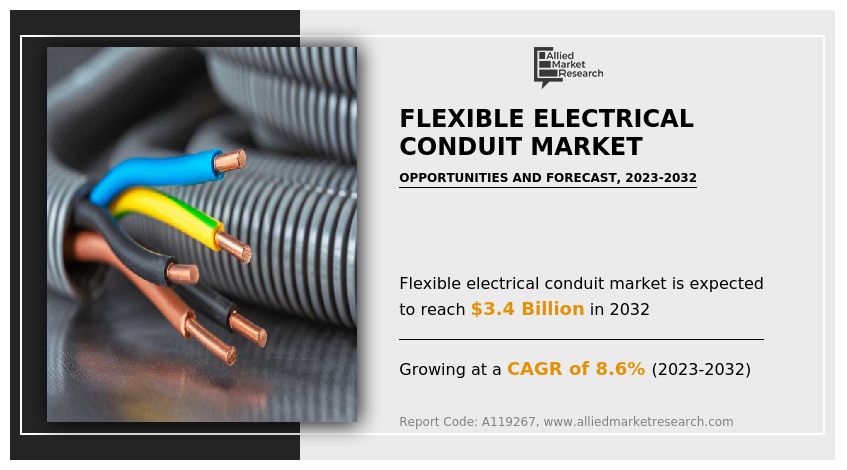
Flexible electrical conduits are a type of tubing designed to supply a flexible and protective pathway for electrical wires and cables. These conduits are used in a range of applications where typical rigid conduits are not suitable or convenient. Flexible electrical conduits are typically made from materials such as PVC (Polyvinyl Chloride), polyethylene, or metal, and come in a variety of sizes and configurations.The flexible electrical conduit market has experienced considerable boom due to its several benefits and various range of applications. One of the key benefits is the flexibility and bendability of these conduits, allowing for handy set up in tight or curved spaces the place rigid conduits would be tough to maneuver. Flexibility also protects against vibrations, movements, and impacts, safeguarding the enclosed electrical wires.
In terms of applications, flexible electrical conduits are widely used in industries such as construction, infrastructure, telecommunications, manufacturing, and automation. Flexible electrical conduits are often employed in constructing wiring systems to protect electrical wiring from harm and provide a secure route for the wires. Conduits be established in walls, ceilings, floors, and outside environments to facilitate electrical connections and ensure the integrity of the wiring system.Flexible conduits are additionally utilized in commercial and industrial settings where machinery, equipment, and automation structures require reliable and included electrical connections.
Flexible electrical conduits are many times located in factories, warehouses, statistics centers, and industrial amenities to guard cables and wiring from harsh conditions, such as exposure to moisture, chemicals, oils, or intense temperatures. Another essential utility of flexible electrical conduits is electrical installations for transportation systems, which includes railways, airports, and highways. These conduits supply a impenetrable and flexible pathway for electrical cables, enabling efficient and reliable power distribution to a number components, such as lighting, signaling systems, control panels, and communication networks.
Furthermore, the rise of smart homes and intelligent constructing systems has contributed to the increase of the flexible electrical conduit market size. These conduits offer a practical solution for concealing and protecting cables used in domestic automation, safety systems, audio/video installations, and other smart devices. It allows for future expansions, modifications, and convenient get entry to to the wiring, supplying flexibility for evolving technologies.
Despite the several advantages, flexible electrical conduits additionally have some limitations. The flexibility and bending capability, while beneficial, impose constraints on the most quantity and dimension of wires that are enclosed. Moreover, the extra components, such as connectors and fittings, required for flexible conduit installations increase complexity and price compared to inflexible conduit systems.
"The Role of Flexible Electrical Conduits in Powering Next-Generation Datacenters"
Flexible electrical conduits play a essential function in powering next-generation information centers by way of presenting a reliable and versatile solution for managing electrical wiring and cables. As data centers continue to evolve and enlarge to meet the growing demands of the digital age, the want for environment friendly and flexible electrical infrastructure becomes paramount.
In the modern-day facts core environment, which encompasses cloud computing, artificial intelligence, massive facts analytics, and IoT (Internet of Things) technologies, the volume of records being processed and transmitted is enormous. This necessitates a rather environment friendly and geared up electrical distribution system that supports the complicated network of servers, storage systems, networking equipment, and different crucial components.One key advantage of flexible electrical conduits in information centers is their ability to adapt to these facilities' dynamic nature. Datacenters frequently require popular modifications, reconfigurations, and expansions to accommodate altering enterprise wants and technological advancements. Flexible conduits without problems accommodate these adjustments as bendy electrical conduits are bent, routed, and adjusted to match the evolving design and infrastructure requirements.
Another essential component is the safety of electrical wiring from achievable hazards. Flexible conduits furnish a bodily barrier that shields the cables from exterior elements such as moisture, dust, heat, and mechanical damage. This safety is essential for making sure the uninterrupted operation of the records core and stopping attainable downtime or gear failures.
Furthermore, flexible electrical conduits provide flexibility in cable administration and organization. With the substantial number of cables existing in data centers, suited cable management is essential to keep a smooth and environment friendly environment. Flexible conduits enable neat and orderly routing of cables, decreasing the threat of tangling, interference, or unintended disconnections. This enhances the average reliability and maintainability of the facts middle infrastructure.In addition, flexible conduits make a contribution to the protection and compliance standards of statistics centers. It helps meet the critical electrical codes and rules by way of providing a tightly closed and accepted pathway for electrical wiring. Compliance with these requirements ensures the protection of personnel, equipment, and data, mitigating manageable dangers and liabilities.
Moreover, as facts facilities devour enormous quantities of energy, effectivity is a necessary factor. Flexible conduits, when used with energy-efficient electrical aspects and systems, contribute to optimizing energy distribution and reducing electricity waste. By minimizing warmth generation and strength losses, flexible conduits help enhance universal strength efficiency, resulting in cost savings and environmental benefits.
The flexible electrical conduit market is segmented on the basis of material type, type, application, and region. By material type, the market is classified into metallic and non-metallic. By type, the market is segmented into the flexible metallic conduit (FMC), liquid tight flexible metal conduit (LFMC), flexible metallic tubing (FMT), and liquid tight flexible non-metallic conduit (LFNC). By application, the market is categorized into rail infrastructure, manufacturing facilities, shipbuilding & offshore facilities, process plants, energy, and others. By region, the market is analyzed across North America, Europe, Asia-Pacific, and LAMEA.
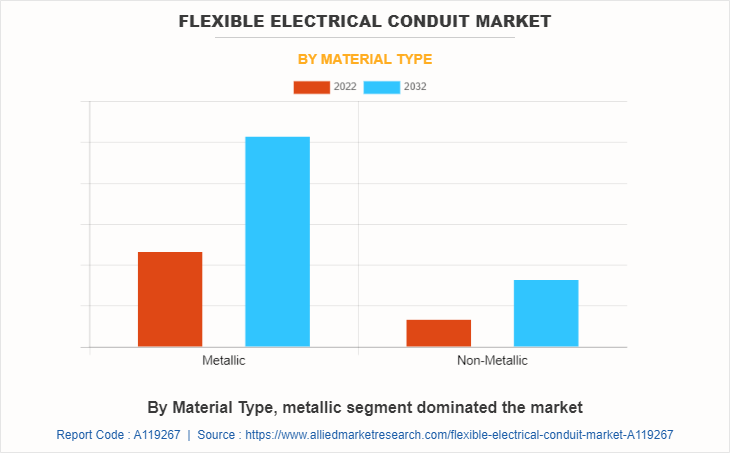
The growth of the construction industry, particularly in emerging economies, is a significant driver for the demand for metallic flexible electrical conduits. As countries invest in infrastructure development, commercial buildings, and residential projects, there is a huge demand for reliable electrical systems and wiring protection which have a positive impact on the flexible electrical conduit market growth.The rapid expansion of industrial and commercial sectors, which includes manufacturing plants, data centers, and warehouses, creates a substantial demand for metallic flexible electrical conduits.
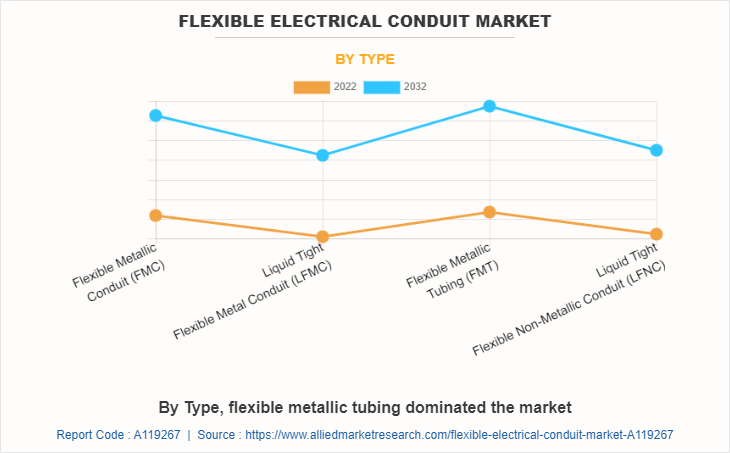
Flexible metallic tubing (FMT) offers exceptional resistance to mechanical stress, vibrations, and harsh environments, making it appropriate for industrial applications. Emerging economies, such as India, Brazil, and Southeast Asian countries, are witnessing rapid urbanization and infrastructure development. These markets present tremendous opportunities for the FMT industry, as there is a demand for reliable and flexible wiring solutions for their increasing building projects.
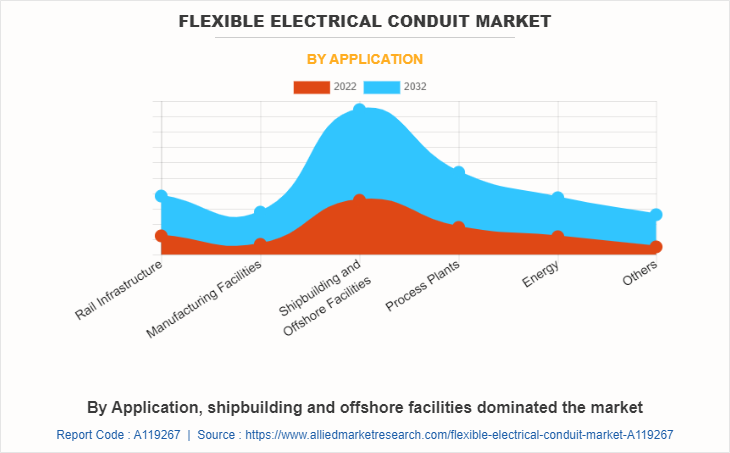
The growing demand for oil and gas has led to increased offshore exploration and production activities. This drives the need for shipbuilding and offshore facilities, creating a positive impact on the demand for flexible electrical conduits. In addition, the expansion of renewable energy sources, such as offshore wind farms, requires the construction of offshore facilities and support vessels. These projects involve extensive electrical infrastructure, which includes the installation of cables and wiring systems. This contributes to the demand for flexible electrical conduits in shipbuilding and offshore industry.
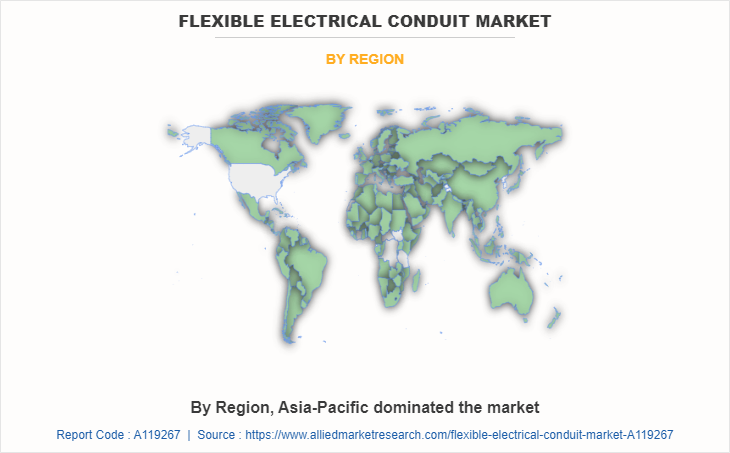
The rapid industrialization and infrastructure development trend, particularly in China and India, which has led to an increased demand for electrical systems and associated infrastructure. This surge in construction and manufacturing activities is driving the need for flexible electrical conduits to ensure safe and reliable electrical installations. In addition, the growing focus on renewable energy sources in countries such as China and India are boosting the demand for flexible conduits in solar and wind power projects.
Moreover, the rising emphasis on smart cities and urbanization initiatives across the region presents further opportunities for the flexible electrical conduit market, as these projects require advanced electrical systems with flexible and efficient conduit solutions.
Key players in the flexible tube industry include ABB, Hubbell, Schneider Electric, Legrand, Southwire Company, LLC., Atkore, Parker Hannifin Corp, Saint-Gobain, NewAge Industries, and Flex Tubes. Apart from the abovementioned profiled companies there are several companies which includes (Electri-Flex Company, AFC Cable Systems, Thomas & Betts, Anamet Electrical, Inc., Calpipe Industries, Inc., Champion Fiberglass, Inc., Aliaxis Group, Dura-Line Corporation, Electrunite Electrical Conduit, Flexicon Ltd., NIBCO INC., Robroy Industries, Inc., SEI Conduit, Eastern Wire + Conduit, Kaf-Tech, Westermann BG, and Zhejiang Leinuoer Electrical Co., Ltd.)
Key Benefits For Stakeholders
- This report provides a quantitative analysis of the market segments, current trends, estimations, and dynamics of the flexible electrical conduit market analysis from 2022 to 2032 to identify the prevailing flexible electrical conduit market opportunities.
- The market research is offered along with information related to key drivers, restraints, and opportunities.
- Porter's five forces analysis highlights the potency of buyers and suppliers to enable stakeholders make profit-oriented business decisions and strengthen their supplier-buyer network in flexible electrical conduit market forecast.
- In-depth analysis of the flexible electrical conduit market segmentation assists to determine the prevailing market opportunities.
- Major countries in each region are mapped according to their revenue contribution to the global market.
- Market player positioning facilitates benchmarking and provides a clear understanding of the present position of the market players.
- The report includes the analysis of the regional as well as global flexible electrical conduit market trend, key players, market segments, application areas, and market growth strategies.
Flexible Electrical Conduit Market Report Highlights
| Aspects | Details |
| Market Size By 2032 | USD 3.4 billion |
| Growth Rate | CAGR of 8.6% |
| Forecast period | 2022 - 2032 |
| Report Pages | 288 |
| By Material Type |
|
| By Type |
|
| By Application |
|
| By Region |
|
| Key Market Players | Schneider Electric SE., ABB Ltd., Flex Tubes, Hubbell Incorporated, Saint-Gobain, Legrand, NewAge Industries, Inc., Atkore International Group Inc., Parker Hannifin Corporation, Southwire Company, LLC |
Analyst Review
According to the insights of CXOs in the flexible electrical conduit market, recognizing the tremendous growth potential of the industry is driven by way of a number of factors. One key driver is the increase in environmental policies and issues surrounding standard electrical wiring systems. CXOs apprehend that there is a developing demand for flexible electrical conduit solutions that offer extended safety, durability, and sustainability.
CXOs believe that the market for flexible electrical conduit will proceed to witness huge boom in the coming years. CXOs apprehend the significance of supplying advanced and progressive elements in their merchandise to meet the evolving wants of customers. This consists of adopting technologies such as artificial intelligence, IoT, and robotics to enhance the functionality and efficiency of flexible electrical conduit systems. By leveraging these innovations, CXOs aim to provide their customers with revolutionary options that optimize electrical wiring practices and make a contribution to sustainable outcomes.
Sustainability is a key focal point for CXOs in the flexible electrical conduit market. CXOs well known that customers, stakeholders, and regulators fee environmentally accountable solutions. Therefore, CXOs strive to develop and promote merchandise and manufacturing techniques that minimize environmental impact. This includes the use of recyclable materials, decreasing carbon emissions all through production, and promoting energy-efficient installations. By aligning their operations with sustainability goals, CXOs goal to appeal to environmentally conscious purchasers and decorate their company reputation.
CXOs additionally apprehend that technological advancements play a imperative role in the growth and innovation of the flexible electrical conduit market. CXOs emphasize the significance of staying at the forefront of emerging technologies such as statistics analytics, automation, and faraway monitoring. By leveraging these technologies, CXOs optimize their manufacturing processes, improve operational efficiency, and ensure regulatory compliance. This commitment to technological development approves CXOs to supply affordable and efficient solutions to their clients, while also driving innovation in the industry.
Shipbuilding and offshore facilities is the leading application of flexible electrical conduit market.
Growth in renewable energy sector, construction industry and increase in industrialization are the leading drivers of the Flexible Electrical Conduit Market.
The flexible electrical conduit market is segmented on the basis of material type, type, application, and region. By material type, the market is classified into metallic and non-metallic. By type, the market is segmented into the flexible metallic conduit (FMC), liquid tight flexible metal conduit (LFMC), flexible metallic tubing (FMT), and liquid tight flexible non-metallic conduit (LFNC). By application, the market is categorized into rail infrastructure, manufacturing facilities, shipbuilding & offshore facilities, process plants, energy, and others.
The estimated industry size of Flexible Electrical Conduit is around $3.4 billion.
Asia-Pacific is the largest regional market for flexible electrical conduit.
Increased adoption of Non-Metallic Conduits, growing Demand for Liquid-Tight Conduits are the upcoming trends of Flexible Electrical Conduit Market in the world
Parker Hannifin Corp, Saint-Gobain, NewAge Industries, Flex Tubes, Hubbell, are the top companies to hold the market share in Flexible Electrical Conduit.
Loading Table Of Content...
Loading Research Methodology...


